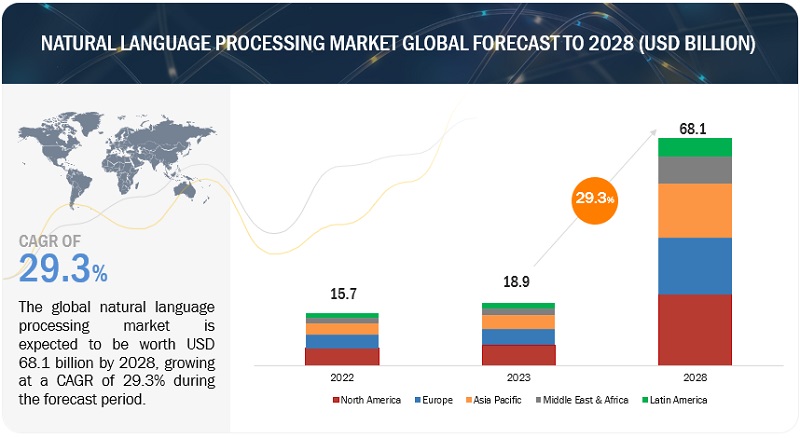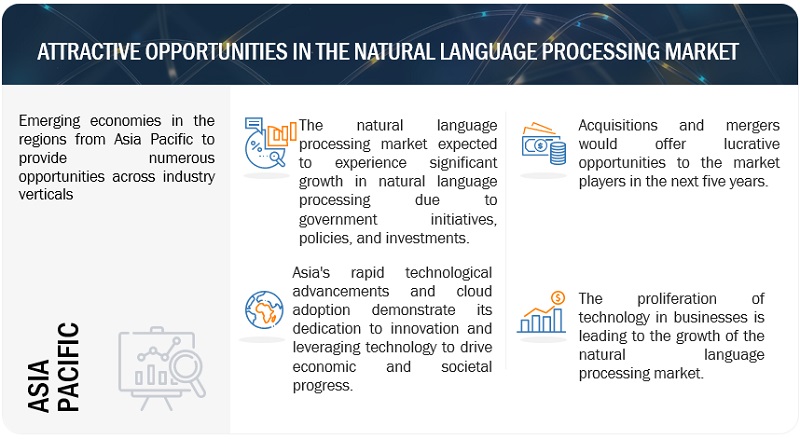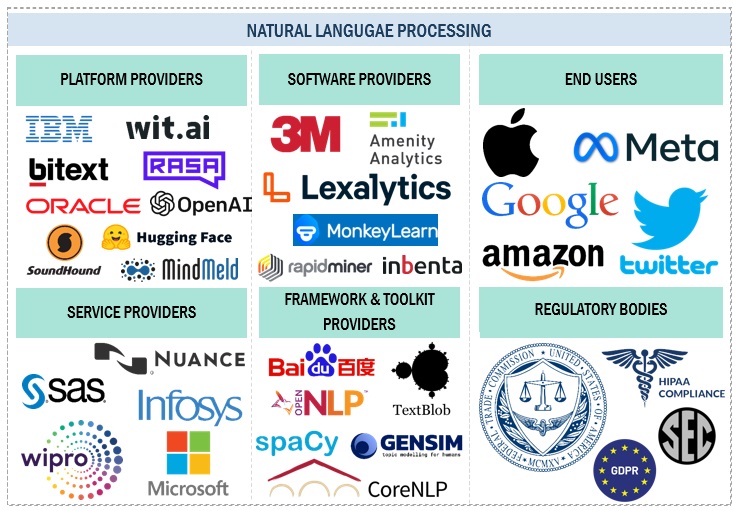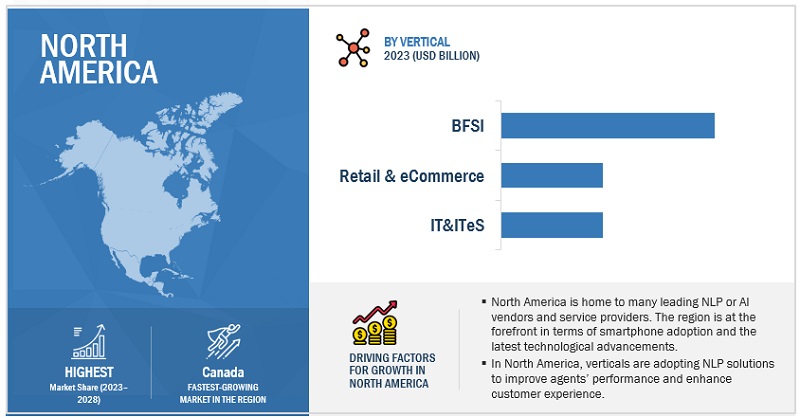※レポートは、MarketsandMarkets社が作成したもので英文表記です。
レポートの閲覧に際してはMarketsandMarkets社のDisclaimerをご確認ください。
[446 Pages Report] The global market for natural language processing market is projected to grow from USD 18.9 billion in 2023 to USD 68.1 billion by 2028, at a CAGR of 29.3% during the forecast period. The growth of the natural language processing market is driven by various factors, including advancements in text-analyzing computer programs, rising need for enterprise solutions to streamline business operations for better customer experience, surging demand for cloud-based NLP solutions to reduce overall costs and enhance scalability and demand for predictive analytics to reduce risks and identify growth opportunities.


Market Dynamics
Driver: Advancements in text-analyzing computer programs
NLP is a technology that enables the processing of human language in the form of text or voice data. It is used in various applications, such as voice-operated GPS systems, digital assistants, speech-to-text dictation software, and customer service chatbots. NLP combines computational linguistics with statistical, machine learning, and deep learning models to create a comprehensive understanding of human language, including the speaker or writer's intention and sentiment. IBM's Watson Natural Language Understanding (NLU) is a tool that analyzes unstructured data formats, including HTML, webpages, and social media, to identify concepts, keywords, categories, semantics, and emotions. It also performs text classification, entity extraction, Named Entity Recognition (NER), sentiment analysis, and summarization.
Restraint : Lack of contextual understanding leading to ambiguity
Natural Language Understanding (NLU) is a process that involves comprehending the context in which language is used. However, understanding the context can be quite challenging due to certain obstacles. Firstly, some words can have multiple meanings, resulting in ambiguity. To eliminate such ambiguities and ensure that such words are precisely understood in a specific document, linguistics has been continuously working on resolving the issue of word sense disambiguation. Secondly, text documents often use domain-specific discourse models, such as legal contracts, news articles, research reports, and many others. These documents have certain properties, such as domain discourse models, that need to be added to AI technology to enhance NLU.
Opportunity: Generative AI acting as catalyst for transforming NLP Market
Generative AI is a revolutionary technology that has transformed the Natural Language Processing (NLP) market. With advanced language models, such as GPT-3 and its successors, generative AI enables the automatic creation of human-like text, which opens doors to several innovative applications. It powers chatbots that can engage in coherent conversations, content generation for marketing and journalism, and personalized recommendations for users. Generative AI offers businesses a cost-effective way to engage their audiences by generating creative and contextually relevant content at scale.
Challenge: Lack of multilingual proficiency
The potential of NLP technology to revolutionize language-based technology has gained significant attention in recent years. However, most of the research and development in NLP has been focused on English and a few other popular languages, leaving a vast number of the world's languages underserved. With approximately 7,000 languages spoken globally, primarily in regions like Asia, addressing this linguistic diversity is crucial to ensure that technological advancements benefit a more inclusive global audience.
Natural Language Processing Market Ecosystem
The natural language processing market report covers market ecosystem which comprises platform providers, software providers, service providers, framework & toolkit providers, end users and regulatory bodies.

By Vertical, BFSI segment accounts for the largest market size during the forecast period
Businesses in the BFSI sector strive to retain customers, reduce expenses, increase revenue, and abide by changing regulations. NLP-based products aid BFSI firms in mitigating risks through tasks such as information retrieval, intent parsing, customer service, and compliance process automation. Major BFSI companies have implemented NLP solutions, such as JP Morgan Chase's COIN, which uses ML software to help its legal teams parse through legal documents. SAS Platform, through its cloud solution integration, claims to have assisted the Royal Bank of Scotland (RBS) in analyzing customer feedback and improving customer experiences using NLP.
Managed Services segment is projected to grow at the highest CAGR during the forecast period
Companies understand the importance of providing excellent client experiences, which is why they often seek out the best players in the market to provide managed services. However, managing these services while also focusing on core business procedures can be challenging. This is where managed services come in. They offer specialized skills to maintain and update NLP software and services, as well as providing pre- and post-deployment support to clients. Many organizations outsource these services to ensure timely support for their clients. MSPs are third-party companies that manage and provide support to the IT infrastructure of NLP providers under a subscription model or Service-Level Agreement (SLA). They are responsible for resolving all hardware and software-related issues.
North America to account for the largest market size during the forecast period
North America comprises developed economies, such as the United States and Canada. Both countries have identified AI as a national policy priority area. Many organizations in the region, especially in the US, have integrated AI, ML, and deep learning technologies into their business processes to stay ahead of the market. AI-based technologies in customer support offer significant financial benefits to organizations that primarily offer call center services. The region's NLP market is experiencing rapid growth due to favorable conditions such as infrastructure development and high adoption of digital technologies. Large-scale investments in AI-enabled infrastructure by startups and established companies have resulted in the development of innovative AI-enabled solutions across various verticals.

Key Market Players
The major natural language processing solutions and service providers include IBM (US), Microsoft (US), Google (US), AWS (US), Meta (US), 3M (US), Baidu (China), Apple (US), SAS Institute (US), IQVIA (UK), Oracle (US), Salesforce (US), OpenAI (US), Inbenta (US), LivePerson (US), SoundHound AI (US), MindMeld (US), Veritone (US), Dolbey (US), Automated Insights (US), Bitext (US), Conversica (US), UiPath (US), Addepto (US), RaGaVeRa (India), Observe.ai (US), Eigen (US), Gnani.ai (India), Crayon Data (Singapore), Narrativa (US), deepset (US), Ellipsis Health (US), DheeYantra (US), Verbit.ai (US), Rasa (US), MonkeyLearn (US), TextRazor (England), and Cohere (Canada). These companies have used both organic and inorganic growth strategies such as product launches, acquisitions, and partnerships to strengthen their position in the natural language processingmarket.
Get online access to the report on the World's First Market Intelligence Cloud
- Easy to Download Historical Data & Forecast Numbers
- Company Analysis Dashboard for high growth potential opportunities
- Research Analyst Access for customization & queries
- Competitor Analysis with Interactive dashboard
- Latest News, Updates & Trend analysis
Get online access to the report on the World's First Market Intelligence Cloud
- Easy to Download Historical Data & Forecast Numbers
- Company Analysis Dashboard for high growth potential opportunities
- Research Analyst Access for customization & queries
- Competitor Analysis with Interactive dashboard
- Latest News, Updates & Trend analysis
Scope of the Report
|
Report Metrics |
Details |
|
Market size available for years |
2017–2028 |
|
Base year considered |
2022 |
|
Forecast period |
2023–2028 |
|
Forecast units |
USD Billion |
|
Segments covered |
Offering (Solutions – [Deployment Mode], Services), Type, Application, Technology, Vertical, and Region |
|
Geographies covered |
North America, Europe, Asia Pacific, Middle East & Africa, and Latin America |
|
Companies covered |
IBM (US), Microsoft (US), Google (US), AWS (US), Meta (US), 3M (US), Baidu (China), Apple (US), SAS Institute (US), IQVIA (UK), Oracle (US), Salesforce (US), OpenAI (US), Inbenta (US), LivePerson (US), SoundHound AI (US), MindMeld (US), Veritone (US), Dolbey (US), Automated Insights (US), Bitext (US), Conversica (US), UiPath (US), Addepto (US), RaGaVeRa (India), Observe.ai (US), Eigen (US), Gnani.ai (India), Crayon Data (Singapore), Narrativa (US), deepset (US), Ellipsis Health (US), DheeYantra (US), Verbit.ai (US), Rasa (US), MonkeyLearn (US), TextRazor (England), and Cohere (Canada). |
This research report categorizes the natural language processing market based on Offering, Application, End User, and Region.
By Offering:
-
Solutions
-
Type
- Platforms
- Software tools
-
Deployment Mode
- Cloud
- On Premises
-
Type
-
Services
-
Professional Services
- Training & Consulting
- System Integration & Implementation
- Support & Maintenance
- Managed Services
-
Professional Services
By Type:
- Rule-Based
- Statistical
- Hybrid
By Application:
- Customer Experience Management
- Virtual Assistants/Chatbots
- Social Media Monitoring
- Sentiment Analysis
- Text Classification & Summarization
- Employee Onboarding & Recruiting
- Language Generation & Speech Recognition
- Machine Translation
- Other Applications
By Technology:
- Optical Character Recognition
- Interactive Voice Response
- Auto Coding
- Text Analytics
- Speech Analytics
- Image & Pattern Recognition
- Simulation & Modeling
By Vertical:
- BFSI
- IT & ITeS
- Retail & eCommerce
- Healthcare and Life Sciences
- Transportation and Logistics
- Government and Public Sector
- Media & Entertainment
- Manufacturing
- Telecom
- Others (Education, Travel & Hospitality, Automotive, and Energy & Utilities)
By Region:
- North America
- Europe
- Asia Pacific
- Middle East & Africa
- Latin America
Recent Developments:
- In August 2023, Meta introduced SeamlessM4T, a groundbreaking AI translation model that stands as the first to offer comprehensive multimodal and multilingual capabilities. This innovative model empowers individuals to communicate across languages through both speech and text effortlessly. Its impressive features include speech recognition for nearly 100 languages, speech-to-text translation for nearly 100 input and output languages, and speech-to-speech translation supporting almost 100 input languages and 36 output languages (including English).
- In August 2023, Google Cloud announced a partnership with AI21 Labs, an Israeli startup revolutionizing reading and writing through generative AI and large language models (LLMs). AI21 Labs utilizes Google Cloud's specialized AI/ML infrastructure to expedite model training and inferencing. This partnership enables customers to seamlessly integrate industry-specific generative AI capabilities through BigQuery connectors and functions.
- In March 2023, Baidu unveiled ERNIE Bot, its latest innovation in generative AI, featuring a knowledge-enhanced LLM. This cutting-edge technology can understand human intentions and provide precise, coherent, and fluent responses that approach human-level comprehension and communication.
- In February 2022, SoundHound AI expanded its partnership with Snap to offer automatic captioning for Snapchat videos. By utilizing SoundHound's Automatic Speech Recognition (ASR) software, Snapchatters can easily generate transcriptions of the audio content in their Snaps in real time. This feature enhances the accessibility and user experience for individuals who may prefer or require captions while viewing videos on the platform.
- In February 2022, Meta announced its latest innovation, the Universal Speech Translator, where Meta is designing novel approaches to translating from a speech in one language to another in real time so it can support languages without a standard writing system as well as those that are both written and spoken.
Frequently Asked Questions (FAQ):
What is Natural Language Prcoessing?
Natural Language Processing (NLP) refers to the branch of computer science, specifically the branch of Artificial Intelligence (AI), concerned with giving computers the ability to understand text and spoken words in much the same way human beings can. NLP drives computer programs that translate text from one language to another, respond to spoken commands, and quickly summarize large volumes of text—even in real time.
Which region is expected to hold the highest share in the natural language processing market?
NLP solutions and services have a huge potential to accelerate businesses. Today, companies use NLP solutions to automatically summarize large data sets and dashboards, machine translation, text classification, and sentiment analysis. NLP solutions and services also help organizations save time and money by enabling employees to focus on value-added tasks; in other words, they reduce the workforce’s efforts.
Which are key end users adopting natural language processing solutions and services?
Key end users adopting natural language processing solutions and services include BFSI, manufacturing, healthcare & life sciences, IT & ITeS, retail & eCommerce, government & public sector, media & entertainment, telecom, and others (education, automotive, travel & hospitality, and energy & utilities).
Which are the key drivers supporting the market growth for natural language processing?
The key drivers supporting the market growth for natural language processing include advancements in text-analyzing computer programs, rising need for enterprise solutions to streamline business operations for better customer experience, surging demand for cloud-based NLP solutions to reduce overall costs and enhance scalability, demand for predictive analytics to reduce risks and identify growth opportunities.
Who are the key vendors in the market for natural language processing?
The key vendors in the global natural language processing market include are IBM (US), Microsoft (US), Google (US), AWS (US), Meta (US), 3M (US), Baidu (China), Apple (US), SAS Institute (US), IQVIA (UK), Oracle (US), Salesforce (US), OpenAI (US), Inbenta (US), LivePerson (US), SoundHound AI (US), MindMeld (US), Veritone (US), Dolbey (US), Automated Insights (US), Bitext (US), Conversica (US), UiPath (US), Addepto (US), RaGaVeRa (India), Observe.ai (US), Eigen (US), Gnani.ai (India), Crayon Data (Singapore), Narrativa (US), deepset (US), Ellipsis Health (US), DheeYantra (US), Verbit.ai (US), Rasa (US), MonkeyLearn (US), TextRazor (England), and Cohere (Canada).


